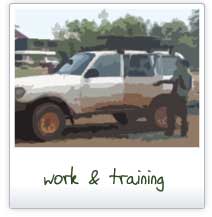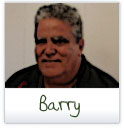 work and training
work and training
The main purpose of participating in Vocational Education and Training (VET) is to achieve qualifications, skills and knowledge to enter or progress through the workforce. In the stories below, learners and trainers talk about how the value and benefits of training are enhanced when training is linked directly to the workplace. The learners and trainers share a variety of models and ways in which this takes place: through work-based apprenticeships, work-place training, work release to attend block training, work placements, and by utilising industry experts in delivery and training.
- What the learners say
- What the trainers say
Don
 Don is a qualified mechanic. He has worked in this role for over 30 years in an Indigenous community.
Don is a qualified mechanic. He has worked in this role for over 30 years in an Indigenous community.
Don talks about practical training and taking small steps
Elizabeth
 Elizabeth is employed as a machinist in a textile art business in an Indigenous community. On the job training is provided by the workplace supervisor.
Elizabeth is employed as a machinist in a textile art business in an Indigenous community. On the job training is provided by the workplace supervisor.
Elizabeth talks about work based training
Cecilia
 Cecilia is employed in the nursery in an Indigenous community. On the job training is provided by the workplace supervisor.
Cecilia is employed in the nursery in an Indigenous community. On the job training is provided by the workplace supervisor.
Cecilai talks about work based learning
Joel
 Joel is a work-based apprentice at a regional university campus. He is currently enrolled in Certificate III in Business and is working in an office environment. He has previously completed Certificate III in Music and Certificate in Commercial Cookery
Joel is a work-based apprentice at a regional university campus. He is currently enrolled in Certificate III in Business and is working in an office environment. He has previously completed Certificate III in Music and Certificate in Commercial Cookery
Joe talks about work and training
Angelee
 Angelee is a work-based apprentice. She is currently enrolled in Certificate III in Business and is working in an office environment.
Angelee is a work-based apprentice. She is currently enrolled in Certificate III in Business and is working in an office environment.
Angelee talks about integrating work and training
Victor
 Victor is a ranger supervisor in an Indigenous community. He has previously completed Certificate III in Conservation and Land Management.
Victor is a ranger supervisor in an Indigenous community. He has previously completed Certificate III in Conservation and Land Management.
Victor talks about BACs role in training
John Ross
 John Ross studied in a VET aquaculture course after he left school. He is now a Teacher Assistant in an Indigenous Community and is enrolled in a Bachelor of Teaching and Learning.
John Ross studied in a VET aquaculture course after he left school. He is now a Teacher Assistant in an Indigenous Community and is enrolled in a Bachelor of Teaching and Learning.
He reflects on his interest in the practical nature of the course and the pathway it provided into employment.
John Ross talks about pathways into employment
Antonio
 Antonio is a Teacher Assistant in an Indigenous Community. While at school he participated in VET in Schools programs in Stock work, Commercial Cookery and Sport and Recreation. He is currently enrolled in a Bachelor of Teaching and Learning.
Antonio is a Teacher Assistant in an Indigenous Community. While at school he participated in VET in Schools programs in Stock work, Commercial Cookery and Sport and Recreation. He is currently enrolled in a Bachelor of Teaching and Learning.
Antonio talks about gaining skills and confidence from participating in a work placement
Jacinta
 Jacinta started working in the health field and commenced VET training in Indigenous health work. Jacinta is now a Teacher Assistant in an Indigenous community. She has completed Certificate III in Indigenous Education Work and is currently enrolled in a Bachelor of Teaching and Learning.
Jacinta started working in the health field and commenced VET training in Indigenous health work. Jacinta is now a Teacher Assistant in an Indigenous community. She has completed Certificate III in Indigenous Education Work and is currently enrolled in a Bachelor of Teaching and Learning.
Jacinta talks about the benefits of combining work and study
Michael
 Michael is a VET lecturer in Conservation & Land Management. He has extensive experience working with and training Indigenous rangers.
Michael is a VET lecturer in Conservation & Land Management. He has extensive experience working with and training Indigenous rangers.
Michael talks about a skills based approach
Michael talks about using industry experts
Yvonne
 Yvonne is the manager, trainer and workplace assessor in the aged care facility in an Indigenous community. Yvonne has tertiary qualifications as well as Certificate IV in Training and Assessment.
Yvonne is the manager, trainer and workplace assessor in the aged care facility in an Indigenous community. Yvonne has tertiary qualifications as well as Certificate IV in Training and Assessment.
Yvonne talks about workplace training
Debbie
 Debbie is the workplace supervisor and trainer in a textile art business in an Indigenous community.
Debbie is the workplace supervisor and trainer in a textile art business in an Indigenous community.
Debbie talks about hands on training
Andree
 Andree is the workplace supervisor and trainer in horticulture at the nursery in an Indigenous community.
Andree is the workplace supervisor and trainer in horticulture at the nursery in an Indigenous community.
Andree talks about hands on training
Cyril
 Cyril works for the health board in an Indigenous community. One of his roles involves the coordination of work based training for staff.
Cyril works for the health board in an Indigenous community. One of his roles involves the coordination of work based training for staff.
Cyril talks about practical training
Cyril talks about hands on training
Allen
 Allen is a musician and music producer as well as a VET trainer in music. He has worked and taught in Indigenous communities for many years.
Allen is a musician and music producer as well as a VET trainer in music. He has worked and taught in Indigenous communities for many years.
Allen talks about the importance of VET training in creating a work force
Allen talks about the role of the VET lecturer in assisting students into work
Barry
 Barry is a VET trainer in Indigenous Education Work. He delivers training in the workplace in an Indigenous community.
Barry is a VET trainer in Indigenous Education Work. He delivers training in the workplace in an Indigenous community.
Barry talks about some of the dilemmas of industry related training in Indigenous communities
Barry talks about adult education versus training
Barry talks about how a trainer can adapt training packages for the needs of the learner group
Strategies for trainers:
Relate training outcomes to workplace practices and to the learner’s immediate needs in order to make learning relevant
Incorporate work placements and real life activities into training
Invite industry experts to participate in training delivery
Teach practical skills in manageable, sequential steps
Make sure one step is practised and mastered before you go on to the next step
Demonstrate all the steps
Acknowledge and incorporate Indigenous ways of knowing and doing alongside the development of skills from the western tradition
Link training to the jobs learners are currently doing in the workforce and ensure that training prepares the learners with the practical skills they need for their current employment and to progress
